Jaguar XKR-S Coupe renews dream of XKE
By John Gilbert
After easing the new Jaguar XKR-S coupe nose-first up to the curb, I climbed out, locked it with the remote, and was walking slowly away, unable to resist the urge to look back at the car’s beautifully coordinated lines. I didn’t even see the fellow approaching from the other direction, but I heard his voice.
“That’s as exotic as it gets,” he said, making more of a statement than a question that needed no answer.
I smiled at him and nodded in agreement. “I mean, you hear about Ferraris and Lamborghinis, but they can’t be any more exotic than this car.”
He was right. The new XKR-S is a long, low, slinky, sexy car, either in coupe or convertible form. This one happened to be the coupe, and it was the cause of a recurring dream for me. I suppose the dream began back when I was a young driver, back in the 1960s, and as I had pulled over in the dark of night on Highway 61, where flashing lights had indicated a patrol car had stopped, fortunately for only a minor accident.
Headlights approached, and a car arrived shortly behind them. Only it wasn’t just another car. When the occupants realized nothing serious had happened, they made a u-turn and drove away, revving to a high-pitched scream as their car disappeared around the corner and into the darkness. The car was a Jaguar XK-E, and its image was riveted in my mind as the most exotic car I had ever seen, first-hand, on the streets or highways near Duluth.
The car, and the British company, have undergone a number of changes over the last 40 years, and the letter designation of the Jaguar sports car has escalated. It is up to XKR by now, but the car has never lost its dreamy characteristics, even though it has gained considerably in the areas of sophistication, technology and performance.
You’ve heard of recurring nightmares, but recurring dreams? My dream may have had a preview way back then on the dark Hwy. 61, but the more solid part of the dream was the brief opportunity to drive the new XKR-S at Road America, the 4-mile road-racing course at Elkhart Lake, Wis. There was a nice mix of cars and automotive media-types when the Midwest Auto Media Association (so help me, it’s MAMA), gathered nearly 100 of each for a two-day performance venture. Media folks have the opportunity to select any car and take it out for a one-lap run, presumably keeping speed within reason.
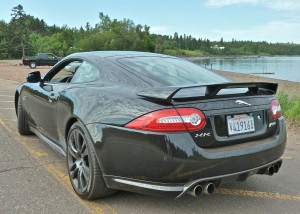
All the lines come together at the spoiler-topped rear, with quad pipes underscoring the "Leaper" emblem.
There were several high-performance cars, ranging from a Corvette, Camaro ZL-1, Cadillac CTS-V hat trick of coupe, sedan, and wagon, and a similar hat trick from Mercedes, including C63 AMG coupe, SLK55 AMG, and SLS Roadster, plus BMW turbocharged sedans, a couple of Audi sedans, a Lancer Evolution GSR, a Nissan GT-R, Lexus GS F, Subaru BRZ, Porsche Carrera S, Genesis Coupe R-Spec, Volkswagen Golf R, Taurus SHO, Mustang Boss 302, Dodge Challenger and Charger SRT8s, Chrysler 300 SRT8, and a Jeep Grand Cherokee SRT8. I drove most of them, on the road course, or later on an autocross, and all were impressive in their various manners.
But I was the most impressed after strolling past the gathered lineup of high-performance cars when I decided to try a dark, black Jaguar XKR-S. I waited in line in the pit area, then was signalled out on the track. Unrestrained by any speed limit, I was pushed back into the seat before Turn 1, then I whistled around the turn and down through Turn 2. That leads onto a long, slightly curving straightaway that ends with a 90-degree left turn at the bottom of an abrupt hill. The Jag felt so comfortable, I had no problem building the speed up through the automatic transmission.
As I swept down the hill, knowing full well I’d have to harness all that speed for the sharp turn, I glanced at the speedometer: It read 140. The brakes were easily up to hauling down from that speed, and I continued around that swift lap before cruising up the exit and back to the paddock parking place.
I drove cars with more power that day, particularly a couple of the Mercedes AMG cars and the Cadillac CTS-V coupe with the Corvette engine, but for some reason, I felt most comfortable interacting with the XKR-S than with any of the more powerful cars. When the day was over, driving back to Minnesota at comfortably relaxed freeway speeds, that Jaguar XKR-S remained my favorite, and I recalled it almost like a dream sequence.
My opinion for years has been that all the statistical evidence every car has, for acceleration or power or fuel economy, is interesting but ultimately less important than the impression you get from driving it. In other words, if it feels fast enough, it IS fast enough. If it’s incapable of the outright speed other cars may boast about, but it feels more comfortable to drive at speed, then that’s more important than its ultimate speed.
Recently, a week-long test drive car arrived for me in Minneapolis. It was a Jaguar XKR-S Coupe. At first, I thought it was a different car, because as I first approached it, the way the sun was hitting it, both my son, Jack, and I thought it was a dark metallic green color; we agreed that the car we’d experienced at Elkhart Lake was black.
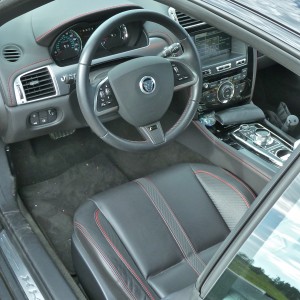
Driver-oriented instruments and controls include high-tech items like the uniquely odd gear-selector.
It was during that week-long drive when the pedestrian made his remark about how nothing could be more exotic than the Jag, and I agreed. The price sticker was inside the car, and when I went to re-examine it, I noticed that it’s color was listed as “Ultimate Black.” Sure enough, despite the multi-colored metallic highlights shining through, the car was actually black. When I went back to photos I had shot at the MAMA event, I was able to compare license numbers, and, to my surprise, it was precisely the same car.
About then I realized that dreams — good dreams — can be recurring. Mine lasted a full week.
The “S” in XKR-S stands for “supercharged.”
Back when Ford Motor Company owned Jaguar and Land Rover, it oversaw Jaguar’s manufacture of a new, lightweight and powerful V8. Now that Jaguar, and Land Rover, for that matter, have been sold by Ford to Tata Motors of India, the Coventry, England-based manufacturer has refined and improved that V8. It now is 5.0 liters, and I’ve driven it in assorted Jaguars.
In the XF Portfolio sedan, and the larger XJL Portfolio, the 5.0 V8 has 385 horsepower, enough to haul those luxurious, classy, but sporty sedans around with ease and flair. You can order more power by selecting the supercharged version of that engine, in case you need to top 500 horsepower with your luxury.
In the 2012 Jaguar XKR-S, the supercharger blows its forceful increased air-fuel mixture into those eight cylinders to stir up 550 horsepower, and 502 foot-pounds of torque, out of that 5.0-liter V8. True, you can get the unblown 5-liter with 385 horses and 380 foot-pounds, or a supercharged version that has 510 horses and 461 foot-pounds, but the king is the fully-blown 5.0 with 550/502 figures.
If you get the car as-tested, you’ll want to be calling ahead to your local road-racing track and see when and how you sign up for track day performance runs. Otherwise, the temptation to violate any and every known speed limit might become too much to ignore. Driving it on the track, for me, reduced my interest in hitting exorbitant speeds to a much more controllable urge.
Awesome as the XKR-S is, at $132,875 it makes you pay for your performance — and the satisfaction of your desire for all things exotic.
Interesting that the supercharged XKR-S basically has too much power for normal driving, its EPA fuel economy estimates show 15 city and 22 highway, and I was able to coax 23.7 mpg in combined city-highway driving.
Inside, the XKR-S has the same classy appeal as the larger sedans. I like nearly everything about the textures and colors that surround occupants, and I’m even getting accustomed to the weird gear-selector. Located at the front of the center console, there is nothing visible until you keylessly start the engine. As it fires up, a small cylinder resembling a small hockey puck, or a diminished tuna fish can — whichever you prefer — rises up from the console. Twist it, and you go from park to neutral, to reverse, to the drive selections.
Fortunately, my anxiety with misidentifying the shift-puck is relieved because the adaptive 6-speed automatic also can be controlled by steering-wheel paddles.
Other standard features include stability control and active differential control, and Jaguardrive modes for winter or dynamic settings. The comfortable “performance” seat envelops you with support, and it’s heated. The steering wheel also is heated.
That said, I would be hesitant to test the 550-horsepower, front-engine, rear-drive, XKR-S with its high-performance tires mounted on 20-inch Vulcan wheels on an attempt to climb an icy avenue in Duluth, Minnesota, on a nice, chilly winter day.
Powerful as the XKR-S is, its audio system is a pretty good match for it. The Bowers & Wilkins system has 525 watts of power, with Bluetooth, Sirius satellite, and high-definition radio filling the interior with the sounds of your choice. No supercharger required.
Warranty coverage includes drivetrain and whole vehicle, plus all scheduled maintenance, and 24/7 roadside assistance — all complimentary for four years or 50,000 miles.
To reach that $132,875 sticker price, the XKR-S has no options. None. The port-of-entry price of $132,000 rises only because of the $875 destination charge to haul it from its Baltimore point of entry to your local dealership. The car is built in Castle Bromwich, U.K., and the engine also is built in the U.K., with the transmission coming from Germany.
For that price, you could also buy a lot of other exotic, or exotic-wannabe, sports cars. But if you can afford one, perhaps you also can afford to find time to road-test all of them. That would leave the decision up to any subjective criteria the buyer wants to stress. But it also might awaken potential customers to the pedigree of the XKR-S.
Its Xenon headlights, by the way, carve sharp perimeters of daylight out of the darkness to help the driver see everything, and they are outlined with LED signature accent lights that have to be judged as extremely neat by those you approach. The headlights, in fact, are so bright, that I wish I’d remembered to take them for a drive up the North Shore on a particularly dark night, and see how much better time has made the Jaguar XK Coupe for driving up to impress anybody seeing it approach and arrive. It could be the stuff of dreams for a whole new generation.
Comments
Tell me what you're thinking...
and oh, if you want a pic to show with your comment, go get a gravatar!


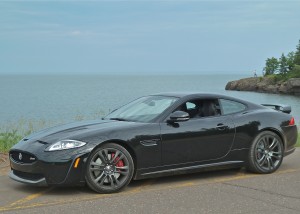
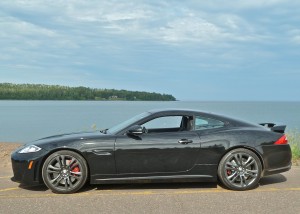
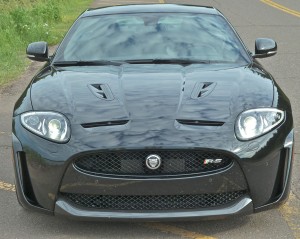
 John Gilbert is a lifetime Minnesotan and career journalist, specializing in cars and sports during and since spending 30 years at the Minneapolis Tribune, now the Star Tribune. More recently, he has continued translating the high-tech world of autos and sharing his passionate insights as a freelance writer/photographer/broadcaster. A member of the prestigious North American Car and Truck of the Year jury since 1993. John can be heard Monday-Friday from 9-11am on 610 KDAL(www.kdal610.com) on the "John Gilbert Show," and writes a column in the Duluth Reader.
John Gilbert is a lifetime Minnesotan and career journalist, specializing in cars and sports during and since spending 30 years at the Minneapolis Tribune, now the Star Tribune. More recently, he has continued translating the high-tech world of autos and sharing his passionate insights as a freelance writer/photographer/broadcaster. A member of the prestigious North American Car and Truck of the Year jury since 1993. John can be heard Monday-Friday from 9-11am on 610 KDAL(www.kdal610.com) on the "John Gilbert Show," and writes a column in the Duluth Reader.